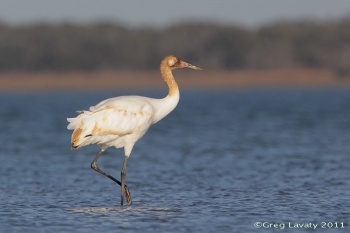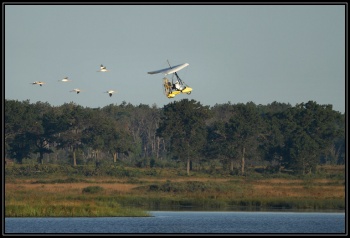- Grus americana
Identification
Body length 130–160 cm (45-50"); stands about 1.5 m (60") tall. Wingspan 200–230 cm (7' 6"); weight 4.5–8.5 kg
A very large crane, pure white with black wing tips, red on forehead and cheeks, black lores and moustachial stripe, and small blackish nape patch.
Young birds similar, but strongly tinged with rufous-brown.
Distribution
The largest population breeds in northern Canada at Wood Buffalo National Park in the Alberta – Northwest Territories border area. This flock winters on Gulf Coast of Texas at Aransas National Wildlife Refuge and more recently a family group have been wintering at Goose Island State Park a few miles up the coast from Aransas NWR. A few winter at Bosque del Apache National Wildlife Refuge in New Mexico.
A smaller population breeds in Wisconsin and winters in Florida. Small resident populations exist in Florida and Louisiana.
[1].
Taxonomy
This is a monotypic species[1].
Habitat
Breeds in freshwater marshes; winters on coastal prairies.
Behaviour
The Wood Buffalo / Aransas flock migrates 4,000 km (2,500 miles) each way between its nesting grounds and its wintering grounds.
Diet
The cranes forage while walking in shallow water or in fields, sometimes probing with their bills. On the wintering grounds in Texas they feed on various crustaceans (blue crabs are a favorite), molluscs, fish (such as eel), berries, snakes and aquatic plants. During the breeding season in Canada, they feed on frogs, mice, voles, smaller birds, fish, reptiles, dragonflies, damselflies, other aquatic insects, crayfish, clams, snails, aquatic tubers, berries, grasshoppers, and crickets. During migration, waste grain is an important food.
Breeding

Photo by earthimages
Central Wisconsin, USA, June 2006
The cranes nest in impenetrable muskeg of the taiga wilderness, on the ground, usually on a raised area in a marsh. 1–3 buff eggs, blotched with brown, are laid and incubation is 29-35 days. The parents often feed the young for 6-8 months after birth and the young leave the parents after about 1 year. Usually no more than one young bird survives each season, but in recent years, several pairs have raised twins, in fact the April 2007 census in Texas, counted seven whooping crane pairs with two chicks each.
Vocalisation
A trumpet-like call that can be heard for several miles.
Conservation Status
The Whooping Crane is on the U.S. Endangered Species List. It is classified as endangered in Colorado, Idaho, Kansas, Montana, North Dakota, Nebraska, New Mexico, Oklahoma, South Dakota, Texas, Utah, and Wyoming. It was reduced by hunting and habitat destruction to about 15 birds wintering in Texas in 1945 and is one of the rarest birds in North America. Strictly protected and monitored since then, the total population has grown to just over 600 in February 2015, of which 310 in the wild population, 132 in re-establishment flocks, and 161 in captivity[2]. The wild population of 310 cranes summers and breeds in Wood Buffalo National Park (wikipedia), Canada, on the Alberta – Northwest Territories border, and winters on the Gulf Coast of Texas at the Aransas National Wildlife Refuge and nearby coastal areas. The winter 2015-2016 census estimated a total of 329 cranes, the highest record yet, and including 38 juveniles[3].
Several programs to re-introduce birds have been made, with mixed, mostly limited, success. An attempt at Grays Lake National Wildlife Refuge in Idaho ultimately failed. Whooping Crane eggs were hatched by Sandhill Crane foster parents, but the resulting offspring, having imprinted on the Sandhill Cranes, failed to mate with other Whooping Cranes. A non-migratory population now lives on Kissimmee Prairie, Florida. As of February 2015, this flock contains 8 birds, a decline from 20 birds in 2011. Ten captive-raised Whooping Cranes were released at White Lake, Louisiana, in February 2011, with further releases bringing the total there to 29 by February 2015. A naturally non-migratory flock had resided here up until 1950.
An attempt to establish a migratory flock to a new flyway east of the Mississippi river, migrating between Wisconsin and Florida, has been made since 2001. This project used isolation rearing of young Whooping Cranes, where they are reared from hatching by people wearing crane costumes, and trained to follow ultralight aircraft. The organization which is responsible for the ultralight migrations is Operation Migration[4], with the larger group WCEP (the Whooping Crane Eastern Partnership), overseeing all aspects of the Eastern Introduced Flock. As of spring, 2011, there are 115 cranes in this flock, but declining to 95 by February 2015. Although survival and migration of the released birds has been good, their breeding success has been very low due to the captive-raised birds lacking natural parenting skills that wild chicks would normally learn from their parents. In 2016 the decision was made to cease isolation rearing of chicks, with any future releases to use naturally-raised young[4].
References
- Clements, JF. 2011. The Clements Checklist of Birds of the World. 6th ed., with updates to August 2011. Ithaca: Cornell Univ. Press. ISBN 978-0801445019. Spreadsheet available at http://www.birds.cornell.edu/clementschecklist/downloadable-clements-checklist
- US FWS 2015 summary
- US FWS Whooping Crane Survey Results: Winter 2015–2016
- Operation Migration
Recommended Citation
- BirdForum Opus contributors. (2024) Whooping Crane. In: BirdForum, the forum for wild birds and birding. Retrieved 8 November 2024 from https://www.birdforum.net/opus/Whooping_Crane







